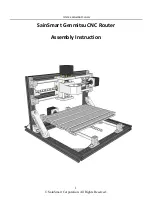
Chapter 15 STP/RSTP Setup
67
In Figure 15-2, below, the WAN link between IP 6610 #1 and IP 6610 #2 has broken. The system
immediately removes the forwarding port block in IP 6610 #4 so that there is still a path between PC #1 and
PC #2
Root
Fwd.
Fwd.
Loop-IP 6610 #2
Root
Fwd.
Fwd.
Loop-IP 6610 #3
Loop-IP 6610 #1
ROOT
Fwd.
Fwd.
PC #2
LAN1
PC #1
LAN1
WAN1
Link
Broken
LAN1
LAN1
WAN1
Root
Fwd.
Loop-IP 6610 #4
Traffic Path
Fwd.
PC #2
Port Block is
removed
PC1 to PC2
link is
recovered
Figure 15-2 Restored STP Link
The spanning tree algorithms supported by this device include these versions:
• STP – Spanning Tree Protocol (IEEE 802.1D)
• RSTP – Rapid Spanning Tree Protocol (IEEE 802.1w)
Spanning tree algorithm uses a distributed algorithm to select a bridging device that serves as the root of
the spanning tree network. It selects a root port on each bridging device (except for the root device) which
incurs the lowest path cost when forwarding a packet from that device to the root device. Then it selects a
designated bridging device from each LAN, which incurs the lowest path cost when forwarding a packet
from that LAN to the root device. All ports connected to designated bridging devices are assigned as
designated ports. After determining the lowest cost spanning tree, it enables all root ports and designated
ports, and disables all other ports. Network packets are therefore only forwarded between root ports and
designated ports, eliminating any possible network loops.
Once a stable network topology has been established, all bridges listen for Hello BPDUs (Bridge Protocol
Data Units) transmitted from the Root Bridge. If a bridge does not get a Hello BPDU after a predefined
interval (Maximum Age), the bridge assumes that the link to the Root Bridge is down. This bridge will then
initiate negotiations with other bridges to reconfigure the network topology. RSTP is designed as a general
replacement for the slower, legacy STP. RSTP achieves much faster reconfiguration (i.e., around one tenth
of the time required by STP) when a node or port fails.
Summary of Contents for IP6610
Page 2: ...2011 Loop Telecommunication International Inc All rights reserved Version 33 23 MAR 2011...
Page 76: ...Chapter 11 Port Forwarding Virtual Service 53...
Page 79: ...Chapter 12 QoS 56 Figure 12 1 QoS Application...
Page 119: ...Chapter 20 Setting Up Firmware Configuration Up Download with TFTP Server 96...
















































